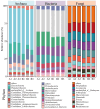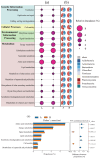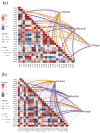Metagenomic Analysis Revealed the Changes in Antibiotic Resistance Genes and Heavy Metal Resistance Genes in Phosphate Tailings Compost
- PMID: 40284605
- PMCID: PMC12029510
- DOI: 10.3390/microorganisms13040768
Metagenomic Analysis Revealed the Changes in Antibiotic Resistance Genes and Heavy Metal Resistance Genes in Phosphate Tailings Compost
Abstract
Phosphate tailings are usually rich in phosphorus and some other mineral nutrients, which is very suitable for composting. In this study, 60 days of composting using phosphate tailings, chicken manure, and straw resulted in a significant decrease in total nitrogen (TN) content from 1.75 ± 0.12 g/kg to 0.98 ± 0.23 g/kg (p < 0.01), with a nitrogen retention of 56%, an increase in water-soluble phosphorus (Ws-P) from 3.24 ± 0.14 mg/kg to 7.21 ± 0.09 mg/kg, and an increase in immediate potassium (AK) from 0.56 ± 0.21 mg/kg to 1.90 ± 0.11 mg/kg (p < 0.05). Metagenomic sequencing showed little changes in the diversity and abundance of microbial communities before and after composting, but changes in species composition and the abundance of archaea, bacteria, and fungi resulted in differences in community structure before and after composting. Composting contributed to a lower gene abundance of ARGs and MRGs. The addition of phosphate tailings combined the functions of chemical regulation and nutrient enrichment, and its synergistic effect significantly optimized the nutrient cycling in the composting system.
Keywords: antibiotic resistome gene; compost; metal resistome gene; microbial community; phosphate tailings.
Conflict of interest statement
The authors declare no conflicts of interest.
Figures






Similar articles
-
Metagenomic Profiles of Yak and Cattle Manure Resistomes in Different Feeding Patterns before and after Composting.Appl Environ Microbiol. 2023 Jul 26;89(7):e0064523. doi: 10.1128/aem.00645-23. Epub 2023 Jul 6. Appl Environ Microbiol. 2023. PMID: 37409977 Free PMC article.
-
Effects of adding corn straw and apple tree branches on antibiotic resistance genes removal during sheep manure composting.J Environ Manage. 2024 Nov;370:122910. doi: 10.1016/j.jenvman.2024.122910. Epub 2024 Oct 15. J Environ Manage. 2024. PMID: 39405860
-
Combined effects of composting and antibiotic administration on cattle manure-borne antibiotic resistance genes.Microbiome. 2021 Apr 1;9(1):81. doi: 10.1186/s40168-021-01006-z. Microbiome. 2021. PMID: 33795006 Free PMC article.
-
Synergistic effects of key parameters on the fate of antibiotic resistance genes during swine manure composting.Environ Pollut. 2019 Sep;252(Pt B):1277-1287. doi: 10.1016/j.envpol.2019.06.073. Epub 2019 Jun 19. Environ Pollut. 2019. PMID: 31252125
-
Combined effects of green manure returning and addition of sewage sludge compost on plant growth and microorganism communities in gold tailings.Environ Sci Pollut Res Int. 2020 Sep;27(25):31686-31698. doi: 10.1007/s11356-020-09118-z. Epub 2020 Jun 4. Environ Sci Pollut Res Int. 2020. PMID: 32500491
References
-
- García-Berumen J.A., Flores de la Torre J.A., de los Santos-Villalobos S., Espinoza-Canales A., Echavarría-Cháirez F.G., Gutiérrez-Bañuelos H. Phosphorus dynamics and sustainable agriculture: The role of microbial solubilization and innovations in nutrient management. Curr. Res. Microb. Sci. 2025;8:100326. doi: 10.1016/j.crmicr.2024.100326. - DOI - PMC - PubMed
-
- Rana M.S., Hu C.X., Shaaban M., Imran M., Afzal J., Moussa M.G., Elyamine A.M., Bhantana P., Saleem M.H., Syaifudin M., et al. Soil phosphorus transformation characteristics in response to molybdenum supply in leguminous crops. J. Environ. Manag. 2020;268:110610. - PubMed
-
- Li Y., Guo S., Zheng Y., Yu J., Chi R., Xiao C. Bioimmobilization of lead in phosphate mining wasteland by isolated strain Citrobacter farmeri CFI-01. Environ. Pollut. 2022;307:119485. - PubMed
-
- U.S. Geological Survey . Mineral Commodity Summaries 2022. U.S. Geological Survey; Reston, VA, USA: 2022. p. 202.
-
- Lustosa Filho J.F., Viana R.d.S.R., Melo L.C.A., de Figueiredo C.C. Changes in phosphorus due to pyrolysis and in the soil-plant system amended with sewage sludge biochar compared to conventional P fertilizers: A global meta-analysis. Chemosphere. 2025;371:144055. - PubMed
LinkOut - more resources
Full Text Sources

